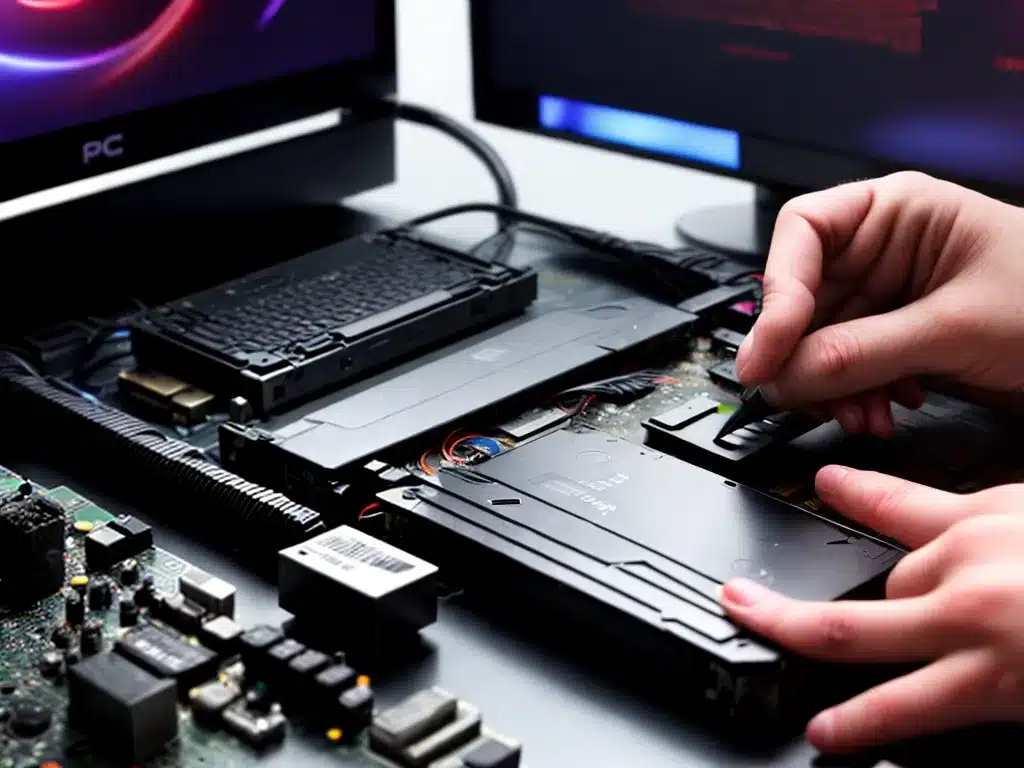
Having your PC suddenly fail to turn on can be frustrating and worrying. However, there are several common causes and solutions that can get your computer up and running again. Here are the main reasons a PC won’t power up and how to troubleshoot them:
Faulty Power Supply
The most common culprit for a PC that won’t turn on is a bad power supply unit (PSU). The PSU converts outlet power into stable voltage electricity that your computer’s components need. If the PSU is defective or fails, your PC will not receive power and will not boot up.
Here are some signs of a faulty PSU:
- PC is completely dead when pressing the power button
- Fans do not spin
- No noise from inside the case
- No lights or activity on the motherboard
To test the PSU:
- Check that the power cable is firmly plugged into the PSU and wall outlet
- Try a different power cable if possible
- Check the voltage switch on the PSU is set to 115V or 230V as needed
- Test the PSU with a multimeter or PSU tester
If your PSU is confirmed faulty, you will need to replace it with a new, compatible PSU for your system. Installing a new power supply unit should restore power and allow your PC to turn on.
Loose or Faulty Power Switch Connection
The next thing to check is the connection between the power switch on your computer’s case and the motherboard.
- Make sure the small power switch cables are firmly plugged into the correct pins on the motherboard.
-
The connection may have come loose which would prevent the PC powering up when pressing the case button.
-
You can short the power switch pins with a screwdriver to test if this is the issue.
-
If shorting the pins turns the PC on, you know the issue is with the case switch or cabling.
-
Reconnect the wires properly or replace the case power switch if needed. This should allow normal power on function again.
Faulty Motherboard Components
If the PSU and case power connections check out, the issue may be with your motherboard itself. Some common culprits include:
-
Faulty power button or reset button on the motherboard. These can prevent startup just like a case switch issue.
-
Defective capacitors or VRMs (voltage regulator modules) which prevent the motherboard receiving or regulating power properly. Bulging or leaking capacitors are a sign of failure.
-
Bios corruption that prevents booting. You may see error lights on the motherboard debug LEDs indicating a corrupted BIOS.
-
Shorts or component failure like a damaged CPU socket or RAM slots that crash the motherboard on power up.
Diagnosing a faulty motherboard section requires inspection of the board and testing components like the RAM. Replacing a motherboard may be required if you can’t determine the exact issue.
Disconnected CPU or RAM
Loose or disconnected components like the CPU or RAM sticks can also prevent successful power up:
-
Check the CPU is firmly seated in the socket with no bent pins. Re-seat the CPU properly if needed.
-
Ensure the RAM is pushed fully into the slots until the retention clips click. Try booting with just one stick at a time.
-
If reseating fixes the issue, the components likely became loose due to heat expansion and contraction over time.
Faulty CPU, RAM or GPU
Along with connection issues, faulty electrical components like the CPU, RAM sticks, or graphics card can also lead to failure to power up:
-
Test components individually by trying different RAM sticks, trying integrated graphics instead of a GPU, or installing a spare CPU if available.
-
If the system boots properly with different parts, you’ve found the faulty component.
-
Damaged or overheated components may need to be replaced before your PC will start up again.
Carefully diagnosing compatibility and connection issues between components can avoid the mistaken purchase of a replacement part you didn’t need.
Corrupted Operating System
Less commonly, serious software and operating system issues can also cause startup failure:
-
Corrupted system files or corrupted boot sectors may prevent your PC booting into Windows properly.
-
Failed Windows updates can also leave systems unbootable.
-
Virus infections damaging critical system areas like the Master Boot Record can block startup.
If you suspect OS corruption, try booting into Windows Safe Mode, running System Restore from recovery options, or reinstalling Windows as a last resort. This may restore boot function if the hardware checks out.
In Summary
Hopefully by methodically checking the common causes above, you can determine what is preventing your PC from turning on and take action to resolve it. Start with the basics like the power supply and connections. Test components for defects. Finally look into OS issues. With persistence and care, you should be able to revive your stubborn PC. Don’t hesitate to consult a repair technician if you exhaust your troubleshooting options.












